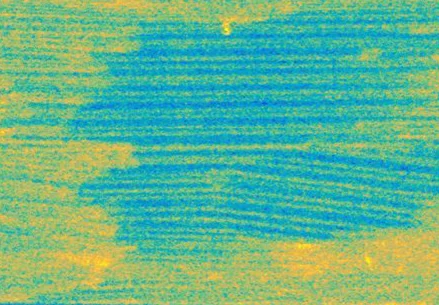Electric steels are indispensible elements of electric machinery and constitute with about 12 million tons per year 95% of the produced soft magnetic materials. They are produced as GRO, grain oriented, and NOR, non-grain oriented steel sheets for applications with a well defined magnetisation direction, like in transformers, or isotropic magnetisation behavior as required in motors or generators, respectively. The key magnetic properties of these materials include their magnetic hysteresis, remanence, saturation and losses, all of which are tied to their domain structure. Thus, the design and conservation of advantageous domain structures throughout the production process of electric machines are of outstanding importance for high energy efficiency. Neutron imaging provides unique insights to the underlying domain structure as it can access the bulk even through the typical coatings that electrical steel sheets require for isolation between each other when assembled.
In particular neutron dark-field contrast imaging [1,2] resolves either individual domain walls, if domains are sufficiently large to be resolved directly, as is the case e.g. in GRO sheets, and if domain walls are aligned close to parallel to the beam. In materials with smaller domains neutron dark-field contrast imaging probes the local density of domain walls. Based on these capabilities we have investigated in the past the domain structure dependence in GRO steel sheets on laser treatments [3] as well as tensile stresses, such as those caused by coatings, as well as their response to alternating external fields [4-6]. It could be visualized at which applied fields and frequencies the domains freeze and cease to adjust to the external stimulus. In a subsequent step we where able to observe in detail the repetitive movement of domain walls in alternating external fields, the speed of domain growth and shrinkage and the point of domain annihilation depending on the applied field parameters. This study enabled sub-millisecond time resolution through a strobo-kinetic imaging approach [7].
In contrast, in NOR steels we investigated the influence of different cutting techniques on the local deterioration of the domain structure in the vicinity of the cutting edge [8]. The background of such studies is that electric steels are produced as sheet material in large dimensions. From these sheets the specific shapes required for a particular electric machine have to be cut, The strain induced at the edges by cutting reduces the magnetic conductivity in these areas and leads to losses impacting the machine performance. Thus, such observations enabling an optimisation of production parameters spurred immediate interest in the respective industry and applied research.
Publications
- J. Valsecchi, Y. Kim, S. Wook Lee, K. Saito, C. Gruenzweig, and M. Strobl, Towards spatially resolved magnetic small-angle scattering studies by polarized and polarization-analyzed neutron dark-field contrast imaging, Scientific Reports 11(1): 8023 (2021)
- J. Valsecchi, M.G. Makowska, C. Gruenzweig, F.M. Piegsa, Y. Kim, S.W. Lee, M.A. Thijs, J. Plomp, and M. Strobl, Decomposing magnetic dark-field contrast in spin analyzed Talbot-Lau interferometry - a Stern-Gerlach experiment without spatial beam splitting, Phys. Rev. Lett. 126, 070401 (2021)
- P. Rauscher, B. Betz, J. Hauptmann, A. Wetzig, E. Beyer, and C. Grünzweig, The influence of laser scribing on magnetic domain formation in grain oriented electrical steel visualized by directional neutron dark-field imaging, Scientific Reports 6, 38307 (2016)
- B. Betz, P. Rauscher, R. P. Harti, R. Schäfer, A. Irastorza-Landa, H. Van Swygenhoven, A. Kaestner, J. Hovind, E. Pomjakushina, E. Lehmann, and C. Grünzweig, Magnetization Response of the Bulk and Supplementary Magnetic Domain Structure in High-Permeability Steel Laminations Visualized In Situ by Neutron Dark-Field Imaging, Phys. Rev. Applied 6, 024023 (2016)
- B. Betz, P. Rauscher, R. P. Harti, R. Schäfer, H. Van Swygenhoven, A. Kaestner, J. Hovind, E. Lehmann, and C. Grünzweig, Frequency-Induced Bulk Magnetic Domain-Wall Freezing Visualized by Neutron Dark-Field Imaging, Phys. Rev. Applied 6, 024024 (2016)
- B. Betz, P. Rauscher, R. P. Harti, R. Schäfer, H. Van Swygenhoven, A. Kaestner, J. Hovind, E. Lehmann, and C. Grünzweig, In-situ visualization of stress-dependent bulk magnetic domain formation by neutron grating interferometry, Appl. Phys. Lett. 108, 1 (2016)
- R. P. Harti, M. Strobl, R. Schäfer, N. Kardjilov, A. S. Tremsin, C. Grünzweig, Dynamic volume magnetic domain wall imaging in grain oriented electrical steel at power frequencies with accumulative high-frame rate neutron dark-field imaging, Scientific Reports 8, 15754 (2018)
- R. Siebert, A. Wetzig, E. Bayer, B. Betz, C. Grünzweig, E. Lehmann, Localized investigation of magnetic bulk property deterioration of electrical steel: Analysing magnetic property drop thorough mechanical and laser cutting of electrical steel laminations using neutron grating interferometry, 3rd International Electric Drives Production Conference (EDPC), IEEE,(2014)
Collaboration
- Dr Peter Rauscher, IWS Frauenhofer, DE
- Dr. Christian Grünzweig, ANAXAM
- Prof. Seung Wook Lee, Pusan University, Korea
Funding
- SNSF Project No. 200021_197048
Associated junior researchers
- Dr. M. Busi, Dr. Y. Kim, Dr. J. Valsecchi



![Figure 2. Measurement of magnetic domain dynamics in grain oriented electric steel subjected to alternating external magnetic fields [7]; left: visualisation of domain structure according to the phase of the external field; middle; line profiles with respect to different external field phases indicating the parameters of magnetic field dynamics; right: same principle of representation for different applied frequencies and field values. Figure 2. Measurement of magnetic domain dynamics in grain oriented electric steel subjected to alternating external magnetic fields [7]; left: visualisation of domain structure according to the phase of the external field; middle; line profiles with respect to different external field phases indicating the parameters of magnetic field dynamics; right: same principle of representation for different applied frequencies and field values.](/sites/default/files/styles/primer_full_image_xxl/public/2021-10/mag_domains2.png.webp?itok=AtTmpFnQ)